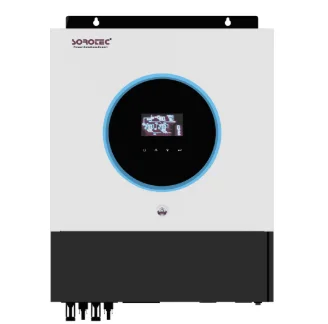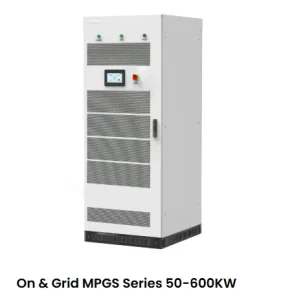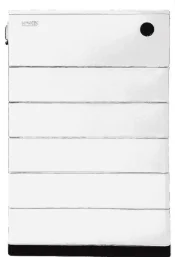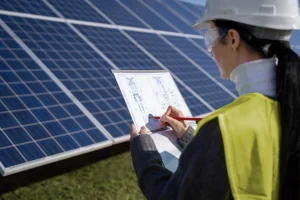Inverter battery voltage significantly impacts solar system power and efficiency. Higher voltages like 48V reduce energy loss, manage heat, and support larger loads, extending component life. Proper battery configuration and voltage matching with inverters like the SOROTEC REVO HM 4/6KW or VM IV Series ensure stability and scalability for homes and businesses. Features like BMS, smart load control, and parallel operation enhance performance. Voltage planning is key for reliable, cost-effective, and durable power solutions.

What Is the Relationship Between Inverter Battery Voltage and System Capacity?
When you’re putting together a solar energy system, the inverter battery voltage is a big piece of the puzzle. It decides how much energy your setup can handle, how well it operates, and whether it stays steady when the demand shifts.
Voltage Level as a Determining Factor for Power Output
Battery voltage is like the force pushing electricity through your system. A higher voltage lets you transfer more energy with lower current. This cuts down on waste in the wires and makes the whole setup run better. If you’ve got batteries, always look at their voltage first. Make sure your inverter matches that number. For example, a basic 12V system might be enough for a tiny house. But for larger tasks or business needs, stepping up to a 48V setup often works better. It keeps things efficient and stops overheating from becoming a headache.
Influence on Inverter Sizing and Load Support
The size of your inverter has to fit with the battery bank’s voltage to keep things safe and running without hiccups. Let’s say you’ve got a 3000W inverter. It could work with a 12V battery pack, such as a 12v 200ah deep cycle battery. That might be a single unit or a few 12V batteries connected side by side. But when your power needs grow, switching to 24V or 48V becomes necessary. Higher voltages handle heavier demands without putting too much strain on wires or other bits.
Compatibility With High-Capacity Energy Systems Like SOROTEC REVO HM 4/6KW
If you’re working with modern hybrid systems like the On & Off Grid REVO HM 4/6KW, matching every part is super important. With a max PV input current of 27A, this model is designed for the newest solar panel tech. It delivers solid energy conversion and steady operation, whether you’re connected to the grid or not. These units are built for higher-voltage battery banks, often around 48VDC. This setup lets you increase your system’s power while keeping everything stable and under control.
How Does Battery Voltage Affect Inverter Efficiency and Stability?
Figuring out the right voltage isn’t just about storage space. It also matters a ton for how well your system holds up over time.
Higher Voltage for Reduced Current and Lower Losses
When you bump up the voltage, the current needed for the same amount of power goes down. So, you can use thinner wires, lose less energy to resistance, and get smoother energy flow through the setup. Today’s systems show this clearly. They’re made with a 27A PV input current to match the growing Imp of solar panels. Their design is adjusted to handle higher voltages, which leads to better results all around.
Improved Heat Management and Component Longevity
Lower current means less heat piling up in wires and circuits. That’s a major win for keeping parts in good shape for years, especially in strong systems like the On & Off Grid REVO VM IV 4/6KW. This inverter is built to keep pace with evolving solar tech and manage power smartly. Operating at higher voltages like 48VDC reduces heat stress. As a result, key components last much longer. Honestly, it’s a lifesaver for anyone who doesn’t want to deal with constant fixes.
Why Is Battery Bank Configuration Critical in System Design?
How you arrange your batteries—stacking them in series or placing them side by side—makes a big difference. It affects voltage, safety, room for growth, and how smoothly things work.
Series vs. Parallel Connections and Their Impact
If you connect batteries in series, the voltage adds up, but the amp-hour rating stays the same. Go with a parallel setup, and it’s the opposite—voltage doesn’t change, but amp-hours grow. Imagine this: four 12V batteries wired in series give you a 48V system, which is great for big inverters. But if you link them parallel, you’re stuck at 12V with four times the amp-hours. That’s not ideal for larger systems where efficiency is key.
Voltage Matching With Inverter Input Requirements
Your inverter’s voltage rating must line up with the battery bank’s voltage. If there’s a mismatch, you’ll get poor results or even a complete failure. This is extra important in setups with multiple inverters, like the On & Off Grid VM IV 6/8/11KW. It can link up to six units together, with neat features like dual MPPT tech and battery balancing. But all that only clicks if the voltage is just right.
How Do Different Applications Influence Ideal Battery Voltage?
The type of task you’ve got—whether it’s for a house or a company—really shapes what battery voltage works best.
Residential vs. Commercial Load Profile
Home setups often stick with lower voltages, like 24V, since the power needs aren’t usually huge. But for businesses or factories, it’s a different story. They need stronger systems, so they often pick 48V or higher to meet bigger demands and run for longer stretches.
Scalability Requirements for Future Expansion
Planning to add more panels or storage later on? Starting with a higher-voltage setup is a smart move. It saves you the trouble of overhauling everything when you’re ready to ramp up your system’s power.
Application Flexibility of On & Off Grid Solutions
Hybrid systems offer tons of flexibility, no matter the demand or if you’ve got grid access. They’re made for both on-grid and off-grid use, fitting all sorts of energy needs. Whether you’re powering a remote cabin or providing backup in a busy city, choosing the right inverter battery voltage ties it all together nicely.
What Role Does Battery Management Play in System Capacity?
Voltage isn’t the only thing to think about. Smart tools for managing batteries are just as vital for getting the most life and reliability out of your setup.
Equalization Function for Prolonged Battery Life
Battery balancing keeps cells from getting uneven, which often causes lead-acid batteries to give out too soon. This feature is a must in any solid energy storage plan. It truly helps your batteries last a lot longer.
Communication Interface With BMS (RS485/CAN)
Modern hybrid systems often come with RS485/CAN ports for real-time updates between the inverter and the Battery Management System (BMS). They include battery balancing to stretch out lifespan and have these ports set up for easy linking with BMS setups.
Intelligent Load Management in Advanced Systems
Smart load control lets you prioritize important circuits when the battery is low or the grid cuts out. Some systems even have two outputs for this purpose. You can set the second output to turn on or off depending on when the battery switches to grid power. Pretty useful, don’t you think?
How Does the Choice of Inverter Model Relate to Voltage Planning?
Picking the right inverter isn’t just about today’s needs. It’s also about looking ahead to growth, and that starts with matching the electrical details.
Matching PV Range and Input Current Capabilities
Your inverter needs to pair well with both your solar panels and battery bank. The three product lines we’ve mentioned work with wide PV ranges (60–450VDC) and max input currents of 27A. That’s ideal for today’s high-power panels, ensuring great energy output every time.
Parallel Operation Support for Higher Loads
If you’re powering an entire building instead of just a small room, you might need multiple units working together. Models like the REVO VM IV Series let you connect up to six units side by side, keeping the output steady. This gives you plenty of space to expand for larger energy demands.
What Are the Practical Considerations When Selecting Battery Voltage?
Besides the technical stuff, there are real-life factors to weigh—like safety rules, ease of setup, and ongoing care.
Safety Standards Compliance and Installation Guidelines
Higher-voltage systems call for stricter safety steps. Think about good insulation, proper fuses, and the right wire sizes. Sometimes, local rules or limits come into play too, depending on your area.
Maintenance Requirements Based on Voltage Levels
Lower-voltage setups often need thicker wires because the current is higher. That can mean checking things more often due to wear from heat or rust over time. It’s a bit annoying, but it comes with the territory.
FAQ:
Q1: What is the maximum recommended inverter battery voltage?
A: Most high-end hybrid systems cap at 48VDC. It’s a great balance that keeps things safe while handling big power needs for homes and businesses alike.
Q2: Can I mix different voltages within one solar system?
A: Nah, mixing voltages between batteries or with the inverter’s rating can cause issues or even damage stuff. The inverter’s voltage rating should match the battery bank’s voltage.
Q3: Do I need a BMS if I’m using lithium-ion batteries?
A: Yup, especially with lithium batteries where balancing cells is crucial. A BMS keeps charging and discharging safe through RS485/CAN ports. They’ve got spots reserved for that connection.









